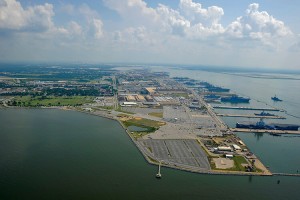From an Article by Sarah Vogelsong, Virginia Mercury, November 5, 2019
If the stalwart presence of the U.S. military in Virginia makes you feel safer in an uncertain world plagued by sea level rise and climate change, a recent report by the U.S. Army War College would like to disabuse you of that sense of security.
According to “Implications of Climate Change for the U.S. Army,” the Department of Defense is “precariously unprepared for the national security implications” of climate change, while the U.S. Army has fostered an “environmentally oblivious” culture.
“In short, the Army is an environmental disaster,” the authors write.
Overall, the report, which was released this August but in the past week has garnered national and international attention, largely focuses on how climate change will heighten the likelihood of global instability. Warmer temperatures and rising seas will not only displace millions of people but endanger water supplies and power grids while fostering new geopolitical tensions, the authors warn.
Not all the risks are overseas. Domestically, military installations are threatened by both power grid vulnerabilities and sea-level rise.
“Department of Defense installations are 99 percent reliant on the U.S. power grid for electrical power generation due to the decommissioning of autonomous power generation capability for budgetary cost saving measures over the last two decades,” the report notes. But as climate change gives rise to more severe storms and weather events like drought and sustained precipitation, these shifts “introduce the possibility of taxing an already fragile system.”
Among the power concerns cited are the vulnerability of the nation’s nuclear power stations, all of which are located near waterways because of the technology’s reliance on water for cooling. This September, the New Republic highlighted the Surry Nuclear Power Station as an “extreme” example of vulnerability, reporting:
“the greatest risk of flood-related catastrophe at the facility would be surge combined with flooding from the nearby James River. A particularly severe flood could result in a maximum water level of 38.8 feet — more than 10 feet higher than the maximum Surry is built to withstand. It’s a highly unlikely combination of events, but a flood of this scale could wreak havoc on electrical systems and require Surry’s operators to try to cool the core in a dangerously flooded facility.”
Sea level rise continues to be the greatest threat to Virginia’s massive military infrastructure. Virginia is heavily reliant on the military: it receives more defense spending than any other state, and that spending makes up a greater portion of its gross domestic product than in any other state. But Virginia is also highly vulnerable to climate change, particularly in Hampton Roads, where the world’s largest naval base is found and the nation’s second-fastest rate of sea level rise is occurring. Earlier this summer, assessments by the four military branches identified six Virginia installations as among the nation’s most threatened military bases.
The Evidence for Climate Change
There is overwhelming consensus among scientists that the Earth’s climate is warming, and that this warming is largely driven by human action. Although regions have always experienced natural temperature fluctuations, long-term temperature records show an “unequivocal” warming trend since the 1950s. Other measurable changes such as accelerated melting of glaciers and ice sheets, sea level rise and increasingly extreme weather provide further clear evidence that warming is occurring. According to the United Nations Intergovernmental Panel on Climate Change, which draws on research by thousands of scientists worldwide, this warming is “extremely likely” (defined as greater than 95% probability) to have been caused by human actions, particularly the release of “unprecedented” levels of greenhouse gases into the atmosphere since the mid-20th century. The U.S. Fourth National Climate Assessment released by the Trump administration in November 2018 similarly found that “observational evidence does not support any credible natural explanations for this amount of warming.”
Sources: IPCC, Climate Change 2014: Synthesis Report; NASA, “Climate Change: How Do We Know?”; U.S. Fourth National Climate Assessment.


{ 1 comment… read it below or add one }
Who Will Pay for the Huge Costs of Holding Back Rising Seas?
Study Report by Jim Morrison, Yale Environment 360, August 5, 2019
U.S. coastal cities face billions of dollars in costs for the extensive infrastructure projects needed to protect against rising seas and worsening storms. From Boston to Miami, government officials are only beginning to grasp the enormous expense of what will be required.
https://e360.yale.edu/features/who-will-pay-for-the-huge-costs-of-holding-back-rising-seas